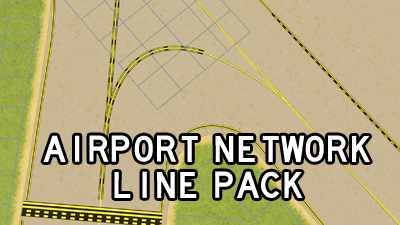Airport Network Line Pack
This is a conversion of my previous airport line prop assets in the form of network segments. These are based off of pedestrian road segments (with the pedestrian lane removed – pedestrians should not use them). These are implemented as geometry with a shared texture atlas, and not as props or decals. These assets are terrain conforming, however, they will very easily clip through airport roads / taxiways if the ground is not perfectly flat.
Note, there are no props in the screenshots.
The colors have been tweaked to appear less saturated and appear more like the real life colors. The asset images have not been updated to reflect this, however, there is a comparison image included.
All of the assets have the same main and LOD geometry, being 192 Tris for a 16m segment. Note that the game appears to stretch the segment while preserving the UV mapping, so that might be 192 Tris for a 64m segment.
For textures, all assets in the pack use the same 1024×1024 diffuse, specular, alpha texture, with a 256×256 LOD diffuse texture.
All of the assets can be found in the same menu as the pedestrian path, and are named LineNet_<name>, where <name> is listed below.
- RedWhite – A red/white line used by plane stands as recommended by the ACI.
- NonMovement – The non-movement area line, single solid with a single dash. These are what mark the boundary between the ramp and the taxiway.
- HSPat2 – A large hold-short marking (denoted as pattern A2 in the ICAO Annex 14). These are used at entrances to runways, to alert pilots that they must stop and request permission from the ATC to proceed.
- HSPat1 – A narrower hold-short marking (denoted as pattern A1 in the ICAO Annex 14).
- ILSPattern2 – A large ILS marking (denoted as pattern B2 in the ICAO Annex 14). These are used to hold aircraft, preventing them from blocking an ILS antenna in use by a landing aircraft. Similar to the hold-short marking, pilots must haver permission from the ATC to cross these.
- ILSPattern1 – A narrower ILS marking (denoted as pattern B1 in the ICAO Annex 14).
- Hold – A hold line. These are used a holding points along the taxiway.
- DoubleY – The double yellow edge line
- CenterThick – A 30cm taxiway centerline.
- CenterThin – A 15cm taxiway centerline.
- ApproachThick – A hold-short approach marking with a 30cm centerline. These markings are used to "enhance" the taxiway centerline, providing further visual feedback that a pilot is approach a hold-short line.
- ApproachThin – A hold-short approach marking with a 15cm centerline.
- DoubleYDashedB – A dashed version of the double-yellow taxiway edge line. These are used to denote taxiway edges which can be crossed by aircraft.
- Red – A thin red line (no black boarder), same thickness as the red in the RedWhite stripe.
- White – A thin white line (no black boarder), same thickness as the white in the RedWhite stripe.
- RedWhiteS – Same as RedWhite, but with straight nodes (no curves).
- RedS – Same as with Red, but with straight nodes (no curves).
- WhiteS – Same as with White, but with straight nodes (no curves).
- RedT – Thicker version of Red line.
- RedTS – Thicker version of Red line with straight nodes.
- WhiteT – Thicker version of White line.
- WhiteTS – Thicker version of White line with straight nodes.
[bold] Pattern 1 vs. Pattern 2 :[/bold] According to the ICAO guidlines, pattern 1 or pattern 2 can be used until the year 2026, where only pattern 2 will be valid. Most international and large domestic airports will use the thicker pattern 2. Both were included, however, in the event that pattern 2 is too large for the aestetic / build you are working on.
– Since these assets are network segments, they will want to snap to everything. As such, they are very fiddly, and I highly recommend using: Fine Road Anarchy, Prop Anarchy, MoveIt, and prop snapping. Note that collisions have been disabled for these assets, however, other network segments (such as taxiways) may end up deleting these lines.
– I found that an efficient way to place these is to lay the segments out in the grass next to the taxiway (using straight segments), and then move them into position / adjust the control points to form curves using MoveIt.
– All of these segments can snap to each other, however, the ones that make the most sense are: center lines + approach lines, and double yellow edge lines + non-movement lines. In both of those cases, the segments will transition smoothly between one another (i.e. the continuous solid-lines line up – see screenshots above).
– While these do conform to the terrain, they have what appears to be 3 z-levels (default, +1 and -1), these can be accessed using pg-up / pg-down (I believe the prop-snapping mod is required, and this can only be done with MoveIt). The 3 z-levels is sufficient to prevent z-fighting at junctions (the approach line junction shown in the screenshot is not connected and was moved with pg-up to prevent z-fighting).
– Since these are network segments, you can use the junction trim trick that works with roads to split, add new nodes, and trim / cut parts of segments.
I accidentally added "linenetwork_doubleYB " which is a duplicate of "doubleYdashedB". I will leave it in there in the event that someone has already used that asset in a save.
All of these assets have the correct widths, however, their lengths have been scaled so that they tile well with a 16m repeated pattern. Other than the tile scaling, all of the assets conform to the ICAO Annex 14 and FAA AC 150/5340-1L.



